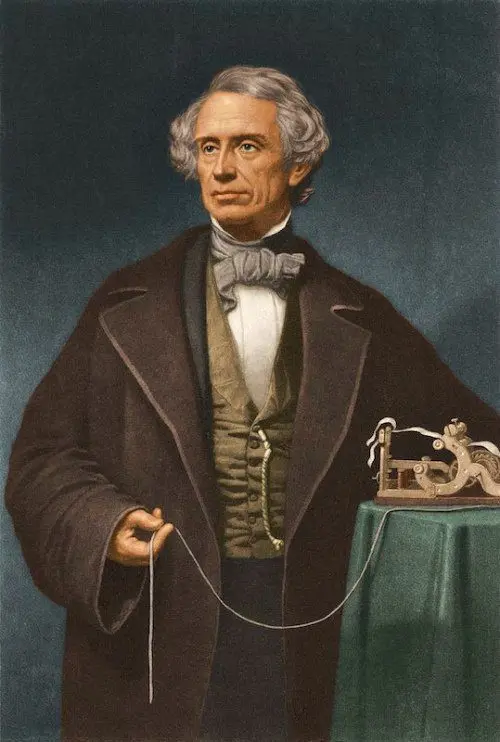Contents
😉 Greetings, friends! Thank you for choosing the article “Samuel Morse: The Biography of the Artist Who Invented the Telegraph” on this site!
180 years ago, on June 20, he received a patent for a telegraph writing device. However, few people know that Samuel Finley Breeze Morse, and we are talking about him, was not only an engineer … but also a famous artist.
Biography of Samuel Morse
The genius (let’s not be afraid of this word) was born in Charlestown – a suburb of Boston, the capital of Massachusetts. The event took place on April 27, 1791 in a respected and wealthy family. The grandfather of the future inventor was the head of Princeton University. His father was considered the best geographer in the country and served as the pastor of the Calvinist Church.
Childhood and youth
Although Sam was raised in austerity, he grew up outgoing and very inquisitive. He was equally attracted to science, technology and drawing. At the age of 14, the boy created the first large-scale painting – a collective portrait of the Morse family.
First, the teenager was sent to an elite private school, Phillips Academy. And then he was transferred to the prestigious Yale College. Here Samuel studied mathematics and philosophy, attended lectures on electricity. He graduated from the university with honors.

Samuel Finley Breeze Morse, 1818. Self-portrait
After working a little as a clerk, the young man decided that he would devote himself to art. Parents had no choice but to pay for his studies at the Royal Academy of Arts – the most authoritative educational institution in Europe.
The artist’s path
The future “father” of the Morse code went to England in 1811. And already in 1813 he received a gold medal for the painting “Dying Hercules”. Two years later, Morse returned home, elated with hope and inspiration.
However, the American establishment did not care about academic painting and, all the more, mythological subjects. Therefore, the artist had to make money by painting portraits.

Samuel Morse “Dying Hercules”. 1833, Yale University
For some time, the artist traveled around the States, offering services to customers. He was a charming person, so he easily acquired not only clients, but also friends. For example, Morse made friends with General Lafayette, writer James Fenimore Cooper, and even Abraham Lincoln.
Personal life
In 1818, 27-year-old Samuel married the charming brunette Lucretia Pickering-Walker. A few years later, having already become a father, he founded a design academy in New York.

Lucrezia Morse with children. 1824, Samuel Morse
The marriage, concluded for love, did not last long, unfortunately. Lucrezia died in 1825, leaving her husband with three young children.
Morse, who was driving around in search of orders, learned about his wife’s serious illness too late. He did not have time to say goodbye to her. It was then that he thought about a device that would transmit messages as quickly as possible.
In 1848 he remarried. His chosen one was Sarah Griswold, a 21-year-old, deaf-mute girl. Despite the obvious misalliance, the couple lived together until the end of their days.
The invention of the telegraph: the year 1837
In 1829 Morse undertook a second trip to Europe. His goal was to study the structure of art schools. But suddenly the painter was carried away by a completely different topic: he again began to experiment with electricity.
The sign of fate for the artist was the incident on the ship, during his return home. On deck, he overheard a conversation that “it would be great to make electric current visible and communicate with it”.
Morse was so imbued with this idea that he cooled off both painting and teaching. He recalled that he was already an electrician, not an artist, from the ship to the shore.
In September 1837, Samuel Morse demonstrated a test telegraph apparatus. However, although the machine transmitted the first message, its text remained unreadable.
For another six months, the electrical artist worked hard on this problem. This is how Morse Code appeared – a way of transferring letters with dots and dashes. And at the Franklin Institute (Philadelphia), a new telegraph system was tested.
In 1844, thanks to Morse’s tenacity, a telegraph line was drawn between Washington and Baltimore. On the day of its opening, Morse tapped out on his phone a phrase from the Bible: “Marvelous are your deeds, Lord!”

It took several more years for copyright disputes with competitors. Until 1854, while the litigation lasted, the inventor’s family, having spent all the money on the telegraph, openly needed funds.
last years of life
But justice prevailed: soon money fell on Morse, because telegraph wires entangled the whole world.
These incomes allowed the inventor to buy an estate near New York, surround himself with grandchildren, books, easels … And do charity work: until the end of his life, the inventor supported schools, universities and church communities.
An extraordinary man died on April 2, 1872. Of course, with the advent of the radio and telephone, the importance of the system he invented dimmed. But the work of Samuel Morse – among them a rare telegraph machine and paintings – still adorn museums, attracting thousands of tourists.
😉 I would be grateful for your feedback on the article “Samuel Morse: Biography”. Admit it, did you know before that the inventor Samuel Morse is an artist? Be sure to look at his paintings on the Internet. There are many of them and they are great!
Subscribe to the newsletter of new articles to your e-mail. mail. Enter your name and e-mail in the line (top right). Share the information “Samuel Morse: Biography” with your friends on social media. networks.









